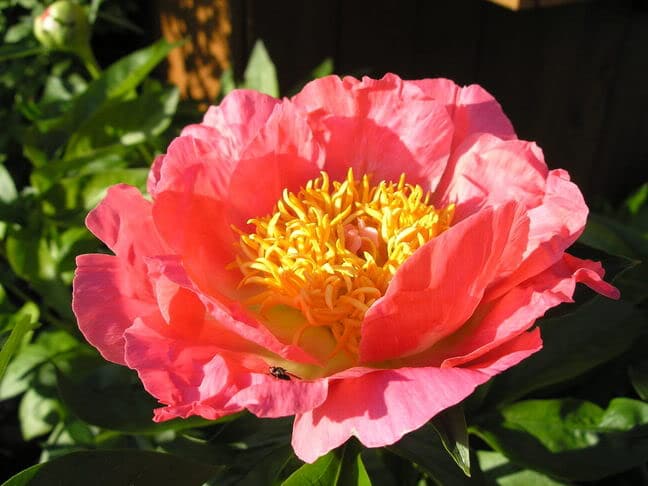
I make a point of approaching herbaceous peonies with the respectful manner a garden dowager is due — given the good care they deserve, peonies can live longer than I will. Therefore, when it’s necessary to move or divide peonies, I make sure I’ve got my best manners and the season is autumn, when these ladies don’t mind a bit of handling.
There are a couple of good reasons why a peony may need to be moved. First, mature peonies make a large clump — sometimes 40 inches (1 m) in diameter — and put out a dozen or more main stems that carry large central flowers and many side blossoms. Even when the flowers are finished and their stems removed, the clump remains large all summer. I’ve sometimes selectively thinned out some of the remaining foliage to reduce the size of the clump, but that’s a gamble, and can result in less energy production. Secondly, peonies that have been in place for many decades sometimes decline in flower production. This can be because of an overgrown root ball, or too much shade from expanding trees and shrubs.
After a decade in one location, peonies make a substantial crown, with many thick finger-like roots. The roots are quite brittle and easily broken, and getting a large peony out of the ground intact should be done carefully and with patience. I use a sharp spade to loosen the root ball, and sometimes a trowel to excavate sections that are holding tightly to the soil. If the crown is very large, it can be cut into sections (each with some roots attached) using a sharp blade. Sections with three to five red buds are the minimum size needed to give a satisfying show next year, but a broken section with only one pink bud is also worth planting. It will grow on to be full size in a few years.
Choose a new location in full sun to part shade with good drainage. I add a lot of organic material to the hole (composted manure, leaves, pine needles and shredded bark), because this plant could potentially live in its new location for several decades before the hole is renovated again. Set the roots and crown shallowly in the hole with the pink buds near soil level — no more than two to four inches (5 to 10 cm) below the surface. If the buds are buried too deeply, the plant may not bloom. Give the plant a good drink of water and cover it with a four-inch (10-cm) layer of leaves. Next spring, push the leaves aside to uncover the plant crowns.
Gardeners have strong opinions about how shallowly the buds should sit in the soil, with some preferring to see the pink buds exposed all winter. I worry about snow melting in mid-winter thaws and freezing as ice directly on the buds, so I set the crown with a moderate amount of soil over top. But I have had peonies go thorough winter with exposed buds, and they did bloom well in spring. Perhaps it’s just a matter of how much your nerves can take when it comes to risking peony blossoms.

Hi there! I transplanted my Grandma’s peonies as my Uncle passed away suddenly & the house is being sold soon (otherwise I would have waited till September to transplant them) This was done in haste during grief & renos.
It was very hot +30 (Zone 3A-4A) and when we moved them, I fear I planted them too deep in our yard (6-8cms deep) This was 2 weeks ago and have been watering them daily ~ they’re in a mostly full sun spot ~but they still don’t look like they’re doing so well.
I would greatly welcome & appreciate any advice on what to do now to help them (2 plants, different colours)
Thanks so much!!
I planted new starts thlast summer. Some got nice leaves. No blooms, I want to move them to better soil and out of way of other flowers. In mountain area if potter county
When we moved to our brand new house and garden fourteen years ago, my husband wanted to move the white peonies from his former home. It was April and the peonies were pushing up new growth. He travelled about three hours with the dug up peonies, no soil, no water and bare root. I despaired that they would perish and planted the limp survivors after sitting in water for a little while. To my surprise they did make it and this spring they again grew to 4 ft and were covered in plate sized white blooms with red centre. Sometimes these matron beauties can survive a shocking move.